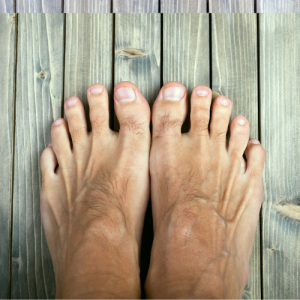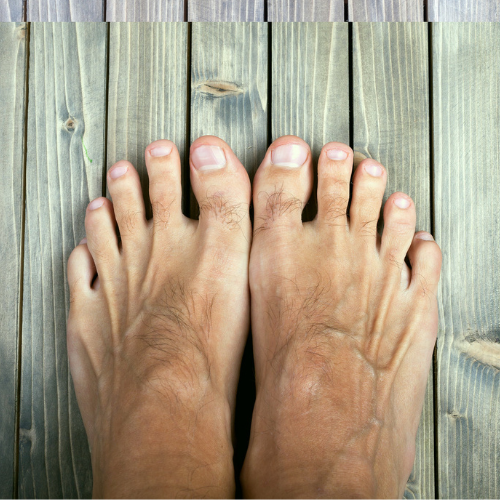 A bunion is a painful bony bump that develops on the joint at the base of your big toe. Your foot shape or the way you walk can cause a bunion. They can form in one or both feet. This foot deformity may occur due to many years of pressure on your big toe (metatarsophalangeal/MTP) joint. The pressure makes the toe joint get out of its’ alignment forming a bony bump medically known as hallux valgus.
A bunion is a painful bony bump that develops on the joint at the base of your big toe. Your foot shape or the way you walk can cause a bunion. They can form in one or both feet. This foot deformity may occur due to many years of pressure on your big toe (metatarsophalangeal/MTP) joint. The pressure makes the toe joint get out of its’ alignment forming a bony bump medically known as hallux valgus.
Bunions occur when the big toe drifts towards the smaller toes and the foot’s outer side, forcing the joint at the base of the big toe to stick out. The bump can be painful, irritated, red, and sore. The pain results from shoe irritation, crowding, and altered mechanical forces in the foot (walking style).
It is best to avoid wearing tight or narrow shoes because they make the bunion worse. Some medical conditions like arthritis or a foot deformity can also cause bunions. Bunionettes (smaller bunions) can form on the small toe.
Bunions develop over time, and it might make walking or wearing shoes painful. Wearing wider shoes can help relieve bunion pain. Bunions are more common in older adults, especially women.
Types of Bunions
The most common types include:
- Congenital hallux valgus: Babies are born with it.
- Tailor’s bunions or Bunionettes: These form outside the base of the little toe.
- Large bunion: These come in different sizes and shapes. Large bunions can make finding suitable shoes difficult.
- Bunion with Hallux Limitus: This is characterized by a limited range of motion in the big toe joint, which causes a bunion to develop on top of it.
- Juvenile or adolescent hallux valgus: This occurs in children between the age of 10 and 15.
Bunion Symptoms
Some signs and symptoms of bunions include:
- Thick skin under the big toe (corns or calluses)
- Swelling, redness, or soreness
- A bulging bump on the outside of the big toe
- On and off pain in the big toe joint
- Hammertoes (tight, painful toe joints)
- Numbness and stiffness in the big toe
- Limited movement of the big toe
- Inability to find shoes that fit comfortably
- Pain and burning when you try to bend the big toe
Bunion Causes
The exact cause is not known. Bunions gradually develop with time and occur because of a faulty foot structure or walking problems. Flat feet can also contribute to the development of bunions. Risk factors include:
- Foot injuries or stress
- Sprains and fractures
- Inherited foot type or family history of bunions
- Pressure from the way you walk or the shape of your foot causing the big toe to bend in towards the second toe
- Excessively standing or walking
- Nerve and muscle conditions like Polio
- Connective tissues disorders like Marfan syndrome
- Wearing ill-fitting, narrow shoes and high heels
- Presence of deformities at birth
- Big toe bone that moves irregularly
- It might be associated with inflammation of rheumatoid arthritis
When to See a Doctor
Bunions often don’t require medical treatment, but see a podiatrist (foot specialist) if you have:
- Decreased range of movement in the big toe
- Persistent pain on the big toe or foot
- A visible bump on your big toe joint
- Difficulty finding fitting shoes because of the bunion
- Difficulty walking
- Severe inflammation or redness in toe joints
Bunion Complications
If you have a bunion, it may increase your risk of:
- Metatarsalgia: This is a condition that causes pain and swelling in the ball of the foot.
- Bone spurs: These are smooth, bony projections that form on the edge of bones.
- Bursitis: It is the inflammation of the small fluid-filled pads cushioning the bones near the joints.
- Osteoarthritis: This is a common form of arthritis that affects weight-bearing joints.
- Hammertoe: This occurs when the middle joint of a toe bends abnormally, mostly the toe next to the big toe, causing pressure and pain.
Diagnosis
Bunions can be diagnosed via visible inspection since they present outwardly. To diagnose bunions, your doctor will physically examine the big toe. They may also order an X-ray to check for joint damage, bone alignment and to determine the cause and best treatment plan. Your doctor may also order a blood test to rule out arthritis.
Bunion Treatment
The goal of treatment is to relieve the symptoms. Symptoms, type of deformity, and other medical conditions such as arthritis or diabetes determine the treatment plan that your doctor will recommend. Depending on the severity of the bunion, your doctor may recommend minimally invasive treatments or surgery. Treatment options include:
- Footwear changes; go for shoes with wide, deep toe boxes
- Over-the-counter pain relievers such as oral and topical nonsteroidal anti-inflammatory drugs (NSAIDs) like ibuprofen.
- Use over-the-counter bunion pads and tapping to cushion the area and relieve pain. Medical tape can help keep the leg in a good position
- Ice packs can help ease pain and swelling
- Orthotic devices, including over-the-counter or custom-made shoe inserts to control alignment issues like pronation that contributes to bunion formation
- Spacers between the big toe and the second toe can also be used for relief
- Splints can be used at night to keep the big toe straight
- Steroid injections to reduce pain and swelling, but they should not be used too often
- Warm foot baths or heating pads to relieve pain
- Physical therapy, massage, and ultrasound help in breaking up soft tissues relieve inflammation and pain
- Exercises also improve muscle strength around the bunion
Surgery
Surgery is recommended when other treatments do not offer pain relief. The goal of surgery is to realign the big toe joint, relieve pain, restore mobility, correct deformity, and full function. Surgery depends on the severity of the bunion, age, and bone strength. The procedure to remove or correct a bunion is known as a bunionectomy. The procedure removes the bony growth and realigns the foot and toe into their normal position. Pins and screws may be inserted to help align the foot.
Bunion Prevention
To prevent bunions, you can use the following tips:
- Avoid pointy shoes; choose wide shoes with a wide toe box.
- Go for shoes that don’t press or squeeze any part of the foot and are not pointed at the tip.
- For flatfeet or inherited structural foot problems, custom-fitted orthotics may help improve the condition and prevent or slow them down
- Avoid wearing high-heeled or tight shoes.
- Choose shoes that conform to the shape of your feet.
- Wear shoes that fit comfortably with minimal or no slippage.
If you have bunions, get treatment as soon as possible to avoid complications, pain, and discomfort.For more information please contact Foot and Ankle Centers.







